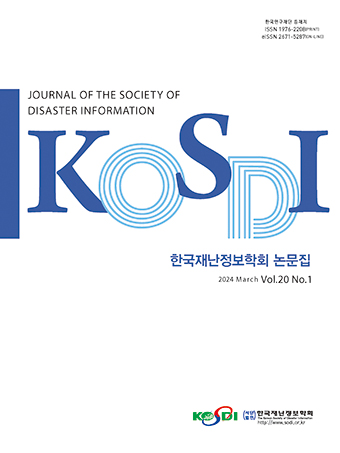Original Article
Abstract
References
Information
Purpose: A reliable indicator of congested traffic speed is essential in providing the information of traffic flow states about motorway sections. The aim of this study is to propose an adaptive indicator of congested speed which is employed for deciding the traffic flow states for individual motorway sections using disaggregated section-based speed data. Method: Typically, the state of traffic flow is categorized into the three: uncongested, mixed, congested states. A method, presented in this study, was developed for identifying boundary speed values of road sections through categorizing the three traffic flow states with individual vehicular speed values. The boundary speed state of each road segment is determined using the speed distributions of mixed and congested traffic states. Result: Analysis results revealed that boundary speed values between mixed and congested states for road sections were similar to those of US and EU criteria (i.e., 48.28~66.0 kph). This indicates that boundary speed values could be different according to road sections. Conclusion: It is expected that the method and indicator, proposed in this study, could be efficaciously used for providing ad-hoc real-time traffic states and computing traffic congestion costs for motorway sections in the era of big data.
연구목적: 고속도로 구간의 소통상태 정보제공에 있어 신뢰성 있는 혼잡속도 지표는 핵심이다. 본 연구는 비집계 구간속도 자료를 이용하여 개별 고속도로 구간의 소통상태를 결정하기 위한 순응형 혼잡속도 지표를 제시하는데 그 목적이 있다. 연구방법: 교통류의 상태는 전형적으로 비혼잡 상태, 혼재 상태, 혼잡 상태로 구분된다. 개별 차량의 속도를 이용하여 교통류 상태를 계층화함으로써 도로구간별 혼잡속도 지표를 산정하는 방법론을 개발하였다. 도로구간별 혼잡속도는 혼재상태와 혼잡상태의 차량 속도분포를 이용하여 결정된다. 분석결과: 도로구간별 혼잡속도는 미국과 유럽의 혼잡속도 기준인 48.28 ~ 66.0 kp와 유사하게 분석되었다. 이는 도로구간별로 혼잡 경계속도가 다를 수 있음을 의미한다. 결론: 본 연구에서 제시된 방법론과 혼잡지표는 빅 데이터 시대의 고속도로 구간별 맞춤형 실시간 소통정보 제공 및 교통혼잡 비용의 산정에 효율적으로 활용될 수 있을 것으로 기대된다.
- Christidis, P., Rivas, J.N.I. (2012). Measuring road congestion. Institute for Prospective Technological Studies (IPTS), European Commission Joint Research Centre.
- GyeongGi-Traffic-Information-Center, https://gits.gg.go.kr/web/trafficInfo/webMapInfo.do, 2021.05.01.
- Korea Transport Institute (2017). Estimation for Road Traffic Congestion Costs in 2017, pp. 60-80.
- Korea Expressway Corporation Research Institute (KECRI) (2019). Establishment of Mid- to Long-term Highway Traffic Operation Improvement Plan and Analysis of Related Indicators, Korea Expressway Corporation.
- Lee, S., Ko, E., Jang, K., Park, S., Park, J., Yun, I. (2020). "Study on the adequacy and improvement of the threshold speed of expressway congestion." The Korea Institute of Intelligent Transport Systems, Vol. 19, No. 5, pp. 40-51. 10.12815/kits.2020.19.5.40
- MOLIT (2020). Transport and Logistics
- Neudorff, L.G., Randall, J., Reiss, R.A., Gordon, R.L. (2003). Freeway management and operations handbook (No. FHWA-OP-04-003). United States. Federal Highway Administration. Office of Transportation Management, U.S.
- Qu, T. (2010). Investigating the effect of freeway congestion thresholds on decision-making inputs (No. UTCM 09-12-11). Texas Transportation Institute, U.S.
- ROADPLUS, http://www.roadplus.co.kr/main/main.do, 2021.05.01.
- Publisher :The Korean Society of Disaster Information
- Publisher(Ko) :한국재난정보학회
- Journal Title :Journal of the Society of Disaster Information
- Journal Title(Ko) :한국재난정보학회논문집
- Volume : 17
- No :3
- Pages :589-599
- DOI :https://doi.org/10.15683/kosdi.2021.9.30.589




 Journal of the Society of Disaster Information
Journal of the Society of Disaster Information







